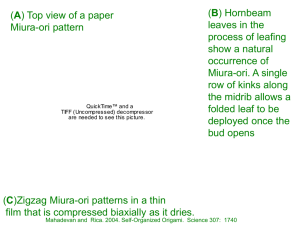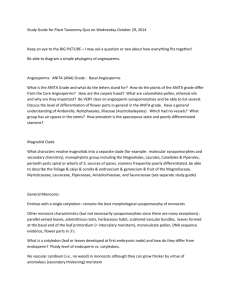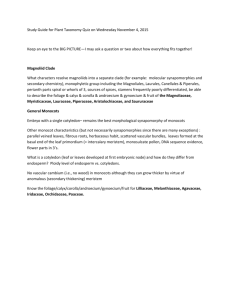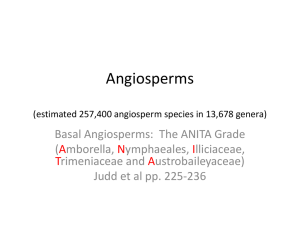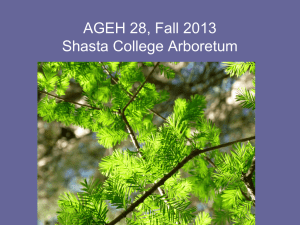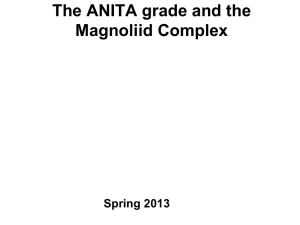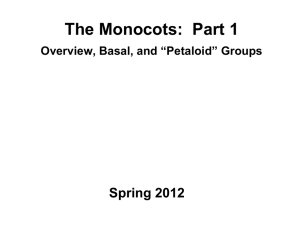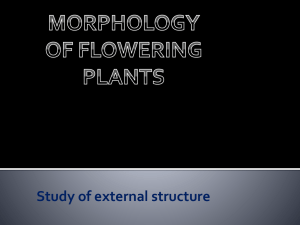Magnoliids I and II
advertisement
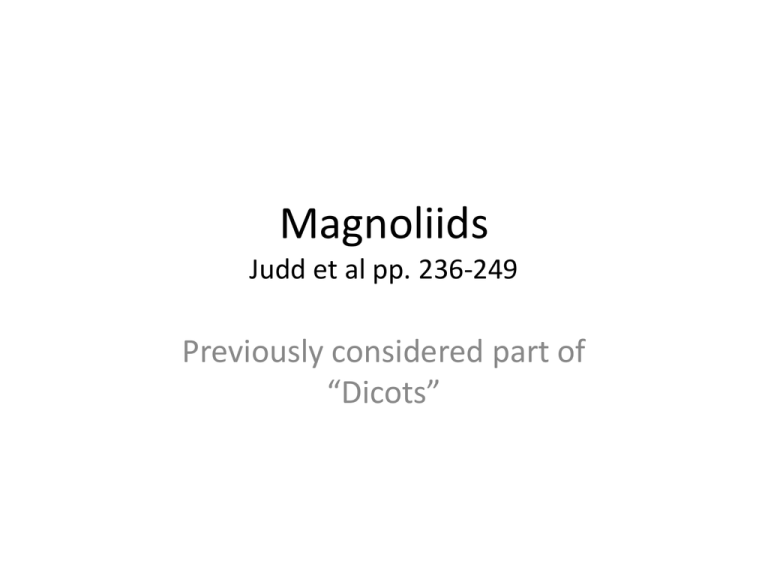
Magnoliids Judd et al pp. 236-249 Previously considered part of “Dicots” Magnolia “on the Mall!” Magnolia on the web Family of unknown position You are here! More than ONE branch at a node means…. IT MEANS WE DON’T KNOW! Magnoliids • Non-monocot, non-eudicot angiosperms • Monophyletic group including the Magnoliales, Laurales, Canellales & Piperales • Perianth parts spiral or whorls of 3 • Stamens flat or leaf like, filament frequently but not always poorly differentiated from the anther (exception= Piperales) • Morphologically similar to ANITA Grade, note that secondary chemistry is given as the best synapomorphy many sources of spices! Magnoliales: Magnoliaceae: 2 genera of Magnoliaceae, 220 species Magnoliaceae • Largest of the 2 genera: Magnolia – 218 species • Other genus is Liriodendron, only 2 species (Tulip Tree) Magnolia grandiflora Louisiana state flower Magnoliales: Magnoliaceae: Magnolia Magnoliales: Magnoliaceae: Magnolia Magnoliales: Magnoliaceae: Magnolia • Fruit– an aggregate of follicles Magnoliaceae: Magnolia— leaf blades with spherical cells (pellucid dots) containing ethereal oils Ethereal Oil • “Aromatic, highly volatile, oily secondary plant products containing monoterpenoids and sesquiterpenoids (and other aromatic compounds), frequently in pellucid dots.” J&C pg. 572 monoterpene Magnoliales: Magnoliaceae: Liriodendron tulipfera Magnoliaceae • Foliage-- Trees/shrubs blade with pellucid dots containing ethereal oils (aromatic terpenoids) • Calyx Tepals • Corolla • Androecium -- Many undifferentiated stamens • Gynoecium-- Numerous distinct • Fruit– aggregate of follicles, seed red, dangles Magnoliales: Myristicaceae • MMy Bark exudes reddish sap when slashed. Myristica: source of nutmeg and mace, from the Spice Islands (Indonesia) Magnoliales: Myristicaceae: Myristica • Seeds of Myristica fragrans (nutmeg tree) are the source of nutmeg; the colorful aril is the source of the spice called Mace. Flowers…3 connate tepals Stamens with filaments connate into solid column Monadelphous! Follicle? Berry? Legume? Capsule? Other?– dehiscent along one/two sides, fleshy, one carpellate flower Magnoliales: Myristicaceae • Foliage– bark exudes reddish sap; blades with pellucid dots containing ethereal oils; contains myristicin (=hallucinogen) • • • • Calyx Three connate tepals Corolla Androecium– filaments connate into a solid column Gynoecium-- one ovule, ovary superior • Fruit– leathery follicle, large seed, colorful aril Laurales: Lauraceae • Trees or shrubs including sources for Sassafras, Cinnamon, Avocado, Bay Leaves, etc. Persea americana A trees and B trees promote outcrossing Laurales: Lauraceae: Laurus nobilis Bay Laurel Laurales: Lauraceae: Cinnamomum • Large genus of over 300 species that is source of camphor, cinnamon, etc. Cinnamomum verum and other species provide the spice. Laurales: Lauraceae: Sassafras • Extract of essential oil is source of perfumes, root beer, candy, and the drug MDMA(ecstasy.) Sassafras candy Fruit is a drupe Sassafras albidum Leaves have pellucid dots Stamens with nectar producing appendages One ovule 6 tepals Laurales: Lauraceae • • • • Foliage– contain ethereal oils Calyx Usually 6 tepals Corolla Androecium— filaments with nectar producing appendages • Gynoecium— one carpel, ovary superior • Fruit– drupe Piperales: Piperaceae: Piper Piperales: Piperaceae: Piper Piper nigrum Piperales: Piperaceae • • • • • • Foliage– contains ethereal oils Calyx No perianth! Spikes of thick, minute flowers Corolla Androecium— filaments distinct Gynoecium— 1 ovule per gynoecium Fruit– drupe Piperales: Aristolochiaceae: Aristolochia watsonii Aristolochia californica Ovary Piperales: Aristolochiaceae • Foliage– ethereal oils with pellucid dots and aristolochic acids, bitter yellow nitrogenous compounds • Calyx– connate, showy, dull red, mottled • Corolla– missing • Androecium– filaments adnate to style • Gynoecium– septicidal capsule • Fruit-- capsule Piperales: Saururaceae: Anemopsis Anemopsis californica Yerba mansa Piperales: Saururaceae: Anemopsis Petaloid bracts Many tiny, white flowers Flowers bisexual (perfect) but no petals or sepals Style Distinct stamens Style Ethnobotany: Antimicrobial • Apparently mostly made from the roots: Petaloid bracts From: Jepson Manual Distinct stamens 3-4 carpels united at the base Piperales: Saururaceae • Foliage– Yes, you guessed it: with ethereal oils • Calyx– Absent! Flowers with a single petaloid bract • Corolla– Absent! • Androecium– 3-8 distinct stamens • Gynoecium– 3-4 carpels united at the base • Fruit-- capsule On to the Monocots! Cyperus esculentus
